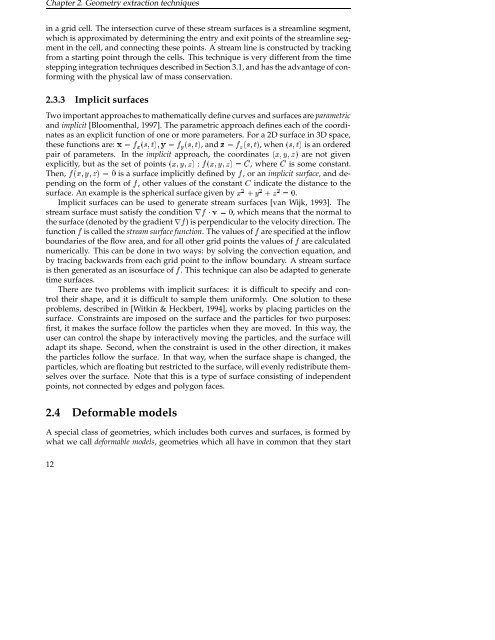Chapter 4 Vortex detection - Computer Graphics and Visualization
Chapter 4 Vortex detection - Computer Graphics and Visualization
Chapter 4 Vortex detection - Computer Graphics and Visualization
Create successful ePaper yourself
Turn your PDF publications into a flip-book with our unique Google optimized e-Paper software.
<strong>Chapter</strong> 2. Geometry extraction techniques<br />
in a grid cell. The intersection curve of these stream surfaces is a streamline segment,<br />
which is approximated by determining the entry <strong>and</strong> exit points of the streamline segment<br />
in the cell, <strong>and</strong> connecting these points. A stream line is constructed by tracking<br />
from a starting point through the cells. This technique is very different from the time<br />
stepping integration techniques described in Section 3.1, <strong>and</strong> has the advantage of conforming<br />
with the physical law of mass conservation.<br />
2.3.3 Implicit surfaces<br />
Two important approaches to mathematically define curves <strong>and</strong> surfaces are parametric<br />
<strong>and</strong> implicit [Bloomenthal, 1997]. The parametric approach defines each of the coordinates<br />
as an explicit function of one or more parameters. For a 2D surface in 3D space,<br />
these functions are: Ü Ü × Ø Ý Ý × Ø , <strong>and</strong> Þ Þ × Ø , when × Ø is an ordered<br />
pair of parameters. In the implicit approach, the coordinates Ü Ý Þ are not given<br />
explicitly, but as the set of points Ü Ý Þ Ü Ý Þ , where is some constant.<br />
Then, Ü Ý Þ is a surface implicitly defined by , oranimplicit surface, <strong>and</strong> depending<br />
on the form of , other values of the constant indicate the distance to the<br />
surface. An example is the spherical surface given by Ü Ý Þ .<br />
Implicit surfaces can be used to generate stream surfaces [van Wijk, 1993]. The<br />
stream surface must satisfy the condition Ö ¡ Ú , which means that the normal to<br />
the surface (denoted by the gradient Ö) is perpendicular to the velocity direction. The<br />
function is called the stream surface function. The values of are specified at the inflow<br />
boundaries of the flow area, <strong>and</strong> for all other grid points the values of are calculated<br />
numerically. This can be done in two ways: by solving the convection equation, <strong>and</strong><br />
by tracing backwards from each grid point to the inflow boundary. A stream surface<br />
is then generated as an isosurface of . This technique can also be adapted to generate<br />
time surfaces.<br />
There are two problems with implicit surfaces: it is difficult to specify <strong>and</strong> control<br />
their shape, <strong>and</strong> it is difficult to sample them uniformly. One solution to these<br />
problems, described in [Witkin & Heckbert, 1994], works by placing particles on the<br />
surface. Constraints are imposed on the surface <strong>and</strong> the particles for two purposes:<br />
first, it makes the surface follow the particles when they are moved. In this way, the<br />
user can control the shape by interactively moving the particles, <strong>and</strong> the surface will<br />
adapt its shape. Second, when the constraint is used in the other direction, it makes<br />
the particles follow the surface. In that way, when the surface shape is changed, the<br />
particles, which are floating but restricted to the surface, will evenly redistribute themselves<br />
over the surface. Note that this is a type of surface consisting of independent<br />
points, not connected by edges <strong>and</strong> polygon faces.<br />
2.4 Deformable models<br />
A special class of geometries, which includes both curves <strong>and</strong> surfaces, is formed by<br />
what we call deformable models, geometries which all have in common that they start<br />
12

















